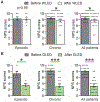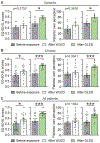Evaluation of green light exposure on headache frequency and quality of life in migraine patients: A preliminary one-way cross-over clinical trial
- PMID: 32903062
- PMCID: PMC8034831
- DOI: 10.1177/0333102420956711
Evaluation of green light exposure on headache frequency and quality of life in migraine patients: A preliminary one-way cross-over clinical trial
Abstract
Background: Pharmacological management of migraine can be ineffective for some patients. We previously demonstrated that exposure to green light resulted in antinociception and reversal of thermal and mechanical hypersensitivity in rodent pain models. Given the safety of green light emitting diodes, we evaluated green light as a potential therapy in patients with episodic or chronic migraine.
Material and methods: We recruited (29 total) patients, of whom seven had episodic migraine and 22 had chronic migraine. We used a one-way cross-over design consisting of exposure for 1-2 hours daily to white light emitting diodes for 10 weeks, followed by a 2-week washout period followed by exposure for 1-2 hours daily to green light emitting diodes for 10 weeks. Patients were allowed to continue current therapies and to initiate new treatments as directed by their physicians. Outcomes consisted of patient-reported surveys. The primary outcome measure was the number of headache days per month. Secondary outcome measures included patient-reported changes in the intensity and frequency of the headaches over a two-week period and other quality of life measures including ability to fall and stay asleep, and ability to perform work. Changes in pain medications were obtained to assess potential reduction.
Results: When seven episodic migraine and 22 chronic migraine patients were analyzed as separate cohorts, white light emitting diodes produced no significant change in headache days in either episodic migraine or chronic migraine patients. Combining data from the episodic migraine and chronic migraine groups showed that white light emitting diodes produced a small, but statistically significant reduction in headache days from (days ± SEM) 18.2 ± 1.8 to 16.5 ± 2.01 days. Green light emitting diodes resulted in a significant decrease in headache days from 7.9 ± 1.6 to 2.4 ± 1.1 and from 22.3 ± 1.2 to 9.4 ± 1.6 in episodic migraine and chronic migraine patients, respectively. While some improvement in secondary outcomes was observed with white light emitting diodes, more secondary outcomes with significantly greater magnitude including assessments of quality of life, Short-Form McGill Pain Questionnaire, Headache Impact Test-6, and Five-level version of the EuroQol five-dimensional survey without reported side effects were observed with green light emitting diodes. Conclusions regarding pain medications reduction with green light emitting diode exposure were not possible. No side effects of light therapy were reported. None of the patients in the study reported initiation of new therapies.
Discussion: Green light emitting diodes significantly reduced the number of headache days in people with episodic migraine or chronic migraine. Additionally, green light emitting diodes significantly improved multiple secondary outcome measures including quality of life and intensity and duration of the headache attacks. As no adverse events were reported, green light emitting diodes may provide a treatment option for those patients who prefer non-pharmacological therapies or may be considered in complementing other treatment strategies. Limitations of this study are the small number of patients evaluated. The positive data obtained support implementation of larger clinical trials to determine possible effects of green light emitting diode therapy.This study is registered with clinicaltrials.gov under NCT03677206.
Keywords: Green light; light therapy; migraine; non-pharmacological therapy.
Conflict of interest statement
DECLARATION OF CONFLICTING INTERESTS
Drs. Ibrahim and Khanna have a patent pending through the University of Arizona for using green light therapy for the management of chronic pain. All other authors have no conflict of interest to report. None of the authors of the manuscript received any remuneration or any reimbursement or honorarium in any other manner. The authors are not affiliated with any vendor or pharmaceutical company associated with this study. Dr. Ibrahim was involved in recruiting and analyzing data.
Figures






Similar articles
-
Green Light Exposure Improves Pain and Quality of Life in Fibromyalgia Patients: A Preliminary One-Way Crossover Clinical Trial.Pain Med. 2021 Feb 4;22(1):118-130. doi: 10.1093/pm/pnaa329. Pain Med. 2021. PMID: 33155057 Free PMC article. Clinical Trial.
-
OnabotulinumtoxinA for treatment of chronic migraine: pooled results from the double-blind, randomized, placebo-controlled phases of the PREEMPT clinical program.Headache. 2010 Jun;50(6):921-36. doi: 10.1111/j.1526-4610.2010.01678.x. Epub 2010 May 7. Headache. 2010. PMID: 20487038 Clinical Trial.
-
A 3-month analysis of disability, quality of life, and disease course in patients with migraine.Headache. 2013 Feb;53(2):297-309. doi: 10.1111/j.1526-4610.2012.02279.x. Epub 2012 Oct 24. Headache. 2013. PMID: 23094760
-
Efficacy and Safety of Galcanezumab for the Preventive Treatment of Migraine: A Narrative Review.Adv Ther. 2020 May;37(5):2034-2049. doi: 10.1007/s12325-020-01319-9. Epub 2020 Apr 21. Adv Ther. 2020. PMID: 32319039 Free PMC article. Review.
-
OnabotulinumtoxinA (BOTOX®): a review of its use in the prophylaxis of headaches in adults with chronic migraine.Drugs. 2012 Apr 16;72(6):825-45. doi: 10.2165/11208880-000000000-00000. Drugs. 2012. PMID: 22468643 Review.
Cited by
-
Monochromatic visible lights modulate the timing of pre-adult developmental traits in Drosophila melanogaster.Photochem Photobiol Sci. 2023 Apr;22(4):867-881. doi: 10.1007/s43630-022-00358-1. Epub 2022 Dec 30. Photochem Photobiol Sci. 2023. PMID: 36583814
-
Light Therapy in Chronic Migraine.Curr Pain Headache Rep. 2024 Jul;28(7):621-626. doi: 10.1007/s11916-024-01258-y. Epub 2024 Jun 12. Curr Pain Headache Rep. 2024. PMID: 38865075 Review.
-
Green Light Exposure Reduces Primary Hyperalgesia and Proinflammatory Cytokines in a Rodent Model of Knee Osteoarthritis: Shedding Light on Sex Differences.Biomedicines. 2024 Sep 3;12(9):2005. doi: 10.3390/biomedicines12092005. Biomedicines. 2024. PMID: 39335519 Free PMC article.
-
Evaluating the Potential of Green Light Exposure on Nociception-A Mini Review.CNS Neurol Disord Drug Targets. 2024;23(6):675-679. doi: 10.2174/1871527322666230522105931. CNS Neurol Disord Drug Targets. 2024. PMID: 37221686 Review.
-
Visual exposure to green light therapy reduces knee joint pain and alters the lipidome in osteoarthritic rats.Pain. 2025 Jun 1;166(6):1274-1284. doi: 10.1097/j.pain.0000000000003458. Epub 2024 Oct 18. Pain. 2025. PMID: 39466034 Free PMC article.
References
-
- Dodick DW. Migraine. Lancet. 2018;391(2018):1315–30. - PubMed
-
- Ceriani CEJ, Wilhour DA, Silberstein SD. Novel Medications for the Treatment of Migraine. Headache. 2019;59(2019):1597–608. - PubMed
-
- Headache Classification Committee of the International Headache Society (IHS) The International Classification of Headache Disorders, 3rd edition. Cephalalgia. 2018;38(2018):1–211. - PubMed
-
- Lipton RB, Fanning KM, Buse DC, Martin VT, Reed ML, Manack Adams A, Goadsby PJ. Identifying Natural Subgroups of Migraine Based on Comorbidity and Concomitant Condition Profiles: Results of the Chronic Migraine Epidemiology and Outcomes (CaMEO) Study. Headache. 2018;58(2018):933–47. - PubMed
Publication types
MeSH terms
Associated data
Grants and funding
LinkOut - more resources
Full Text Sources
Other Literature Sources
Medical
Research Materials

